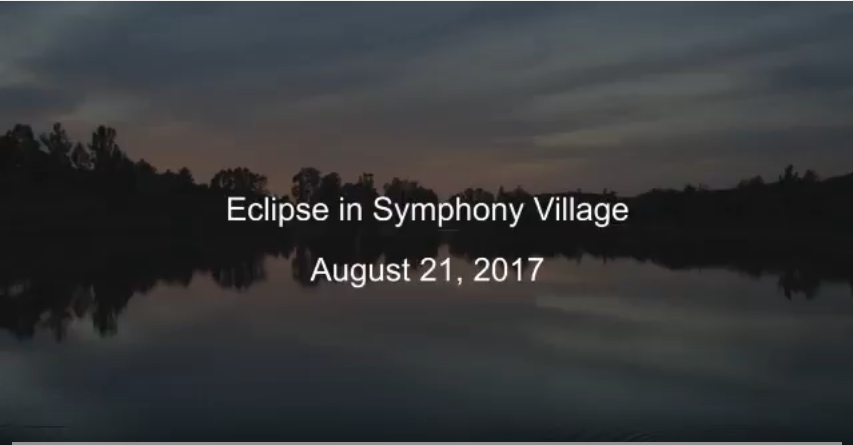Village Astronomy Club
Larry Rayner, Armchair Astronomer
Our first observing session was held after our June 2 Happy Hour where we got to see the moon and its craters and Jupiter and four of its prominent moons (the same satellites observed by Galileo in 1610). The Astronomy Club now has almost 30 members. I have had a broken hip set-back since then but plan to be back for the next big event, the solar eclipse on Monday, August 21. Showtime: 2:40 PM
We can't have such an event without a Lifestyle Party!!
We will be set up for lunch at 12:30. Susan is fixing a spiral ham and rolls and a shrimp and pasta salad. It would be nice if everyone added to the buffet table. The Lifestyle Committee is doing all it can to stream the Total Solar Eclipse on the big screen while we experience the 90% Eclipse from our Clubhouse. Lifestyle will provide 50 pairs of glasses that are ISO certified for safety. Your glasses should have a certification of ISO12312-2.
A 90% Solar Eclipse Comes to Symphony Village
“A Total Eclipse of the Sun is a moment of magic: a scant few minutes when our perceptions of the whole universe are turned on their head.”... Peter Coles
While we would have to travel to South Carolina to experience the Total Eclipse, and some lucky residents are, we can still see something pretty spectacular and a once in my lifetime event. As far back as 2134 BC, Solar Eclipses have been a source of legends, myths, and omens. From the story of Hsi and Ho who were put to death for failing to predict the Eclipse in China to the more enlightened time of the 17th century when Johannes Kepler gave a scientific description of a Total Solar Eclipse (TSE). Far from being harbingers of death and destruction, a TSE was responsible for the discovery of Helium in 1868 by French astronomer Jules Janssen. The Solar Eclipse in 1919 helped Sir Arthur Eddington to prove Albert Einstein’s theory of relativity. He was able to prove that gravity can bend light (gravitational deflection) with the aid of photography. Solar Eclipses occur every year and more than once a year. The maximum number of Solar Eclipses in a calendar year is 5. Rare though it is, the last time a TSE happened was 1935, and it won’t happen again until 2206. So, if you can see a Solar Eclipse every year and as many as 5 in a year, why all the fuss? Because a SE is only visible from a very limited path on earth and, unless you are a SE chaser, this “path” happens once in a lifetime, if that. Delaware’s last TSE was July 29, 1478. Don’t plan on being around for the next one; it will occur on September 12, 2444. On average, a TSE reoccurs at a specific location every 375 years. A TSE can only occur around a New Moon because of the alignment of the Earth, Moon, and Sun. The New Moon and Sun have to be near a lunar node (2 points where the plane of the Moon’s orbit path around the Earth meets Earth’s orbital plane around the Sun, The Ecliptic). August 21 will be the first TSE in North America since March 1979 with the next one not occurring until April 2024. Not being an Eclipse chaser, this is my chance to see at least a 90% Solar Eclipse. I hope you will join the Astronomy Club members for a “pot luck” luncheon (asking residents to bring a lunch item to share) in the ballroom at 12:30 p.m. We will have interesting facts, computer simulated Total Eclipses, and with luck watch our 90% Eclipse around the pool and the Total Eclipse via NASA streaming at 2:30 p.m. There is a sign-up sheet in the Activities Book so we know how many to plan for, and we have purchased 100 pairs of “eclipse glasses” for our viewers.
The Bubble Nebula, also known as NGC 7635, is an emission nebula located 8,000 light years away in the Cassiopeia constellation. The bubble is created by stellar wind pushing out from a massive hot central star, visible here just left of the center of the image, a purple star partly obscured by blue gas clouds. The nebula is seven light years across—about one-and-a-half times the distance from our sun to its nearest stellar neighbor, Alpha Centauri. This stunning image was observed by the NASA/ESA Hubble Space Telescope to celebrate its 26th year in space.



